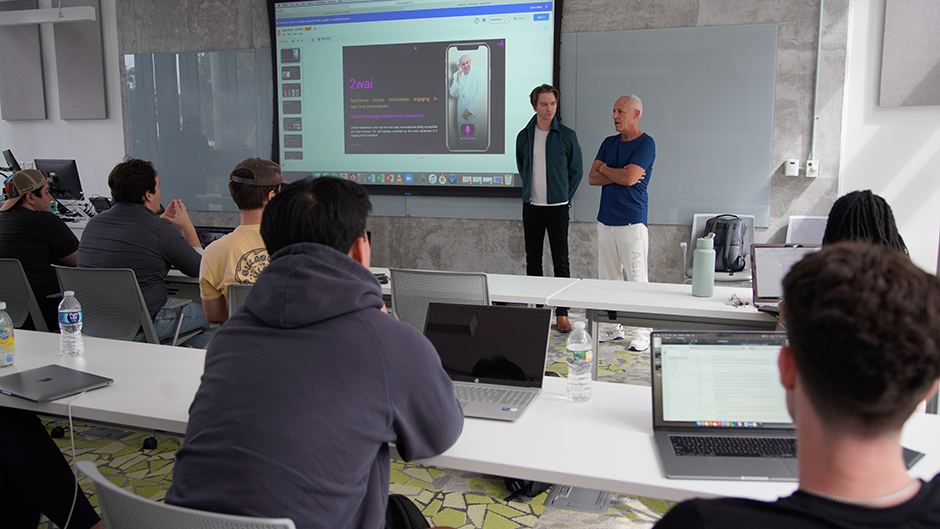It’s not every day that a celebrity and a Hollywood producer ask students to collaborate with their company.
But that’s what happened at the University of Miami College of Arts and Sciences in Introduction to Innovation and Society, a course on a creative problem-solving approach known as design thinking that is often employed in business and technology.
Calum Worthy, the actor best known for his role in Disney Channel’s “Austin & Ally,” and Russell Geyser, an acclaimed film producer, visited the class on Oct. 17 so they could tell students about their new technology and ask for ideas on possible applications.
Their company, 2wai, offers three-dimensional artificial intelligence avatars that users can create with their smartphones. Users record themselves speaking for three minutes to create an interactive avatar of themselves. After that, the user can text whatever they want the avatar to say, and the avatar will speak in the user’s voice in any language.
One application for the technology, Worthy and Geyser told students, is helping celebrities communicate with fans who speak other languages. Worthy explained that he has met fans in other countries who don’t recognize his voice because they’ve only seen his show dubbed in another language.
“I travel a lot, and a lot of people come up to me, and the first thing they say is that my voice sounds so different,” Worthy said.
In addition to offering the technology to celebrities, Worthy and Geyser are also creating avatar versions of cartoon characters. But, they told the students, they want to know if there are other applications they haven’t thought of for the technology.
“What we’re really here to ask you guys is, A, are we thinking about use cases correctly from your point of view?” Geyser said. “And secondarily, are there other use cases that we’re not thinking of because we didn’t come out of the Gen Z mindset?”

Those are the questions students in the Innovation and Society class will answer for their final project. They will work in teams to come up with possible applications for the technology and then present their ideas to Worthy and Geyser later this semester.
The class is the introductory course for a new co-major focused on design thinking that the College began offering this fall. As a co-major, it can be combined with any other undergraduate major at the University, teaching students a problem-solving approach they can apply to any field.
“The co-major emphasizes real-world impact in our course projects, so we are very excited about supporting the development of such an exciting technology,” said Ben Lauren, director of the Innovation and Society co-major and chair of the Department of Writing Studies.
When the introductory course was offered for the first time in the spring, the class projects included designing a Pokémon GO-style game for the University’s Lowe Art Museum and designing a studio for the co-major in a former office space.
Daisy Brody, a senior in the class who is majoring in community and applied psychological studies, said she is looking forward to completing the new project.
“Having grown up watching Calum Worthy, I’m excited to collaborate with him in the design thinking class,” she said. “It’s a great opportunity to work with someone I’ve always enjoyed seeing on-screen.”
To kick off the design thinking process, the students asked Worthy and Geyser questions about 2wai. They wanted to know why the company’s technology is less expensive than its competitors’ and how celebrities can control who has access to their avatar.
Although the students were just starting to think about possible applications, the collaboration already appeared to be working.
Noah Siegel, a sophomore majoring in environmental science, asked if the avatars could be used to communicate in sign language with people in the deaf community.
“That’s a great question,” Worthy said. “We haven’t explored that yet. I’m glad you brought that up.”
